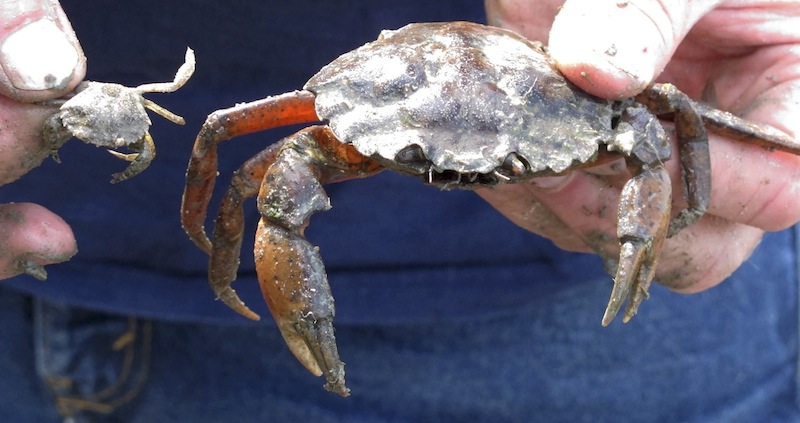FREEPORT — Voracious green crabs are overtaking hundreds if not thousands of acres of mudflats along the Maine coast, cleaning out soft-shell clams and posing a threat to other shellfish, officials said Wednesday.
Prompted by the invasion of the crabs, the Department of Marine Resources this week oversaw a one-day coastwide survey to gauge the abundance of the crabs and provide a snapshot of the population. About 40 volunteers in 30 coastal towns set baited traps Tuesday and pulled them Wednesday.
The results will be used to raise public awareness and help towns develop plans to control them.
If the crabs are left unchecked, there might not be a viable clam-digging industry in a couple of years, longtime clam digger Chad Coffin of Freeport said at a news conference along the shore of this town 15 miles north of Portland. Soft-shell clams were Maine’s third most-valuable seafood species last year.
“If you like clams, you’re in trouble. There might not be any,” said Coffin, president of the Maine Clammers Association.
Green crabs are native to Europe, dark brown to dark mottled green in color with shells up to 4 inches across. They first arrived in New England in the 1800s, most likely in a sailing ship’s ballast water, and were first spotted in Maine waters in 1900. They have since spread along much of the East Coast and migrated to the West Coast.
Maine has two native crab species, Jonah and rock crabs, that are caught for their meat, but green crabs have little meat and aren’t fished commercially.
Although they’ve been a nuisance on-and-off through the decades, green crab numbers have grown fast in the past few years, most likely because of warming ocean waters, officials say. Their populations have also been growing in their entire East Coast range from Virginia to Newfoundland.
There are so many of the crabs in nearshore waters, particularly in Casco Bay and the midcoast areas, that they’ve cleaned out entire clam flats and are thought to have decimated mussel populations as well, Coffin said.
They are a significant threat to the state’s $15 million clam industry, as well as to mussels, scallops and other shellfish, said Marine Resources Commissioner Pat Keliher.
“Green crabs are the No. 1 threat to that portion of our coastal economy,” he said.
The crabs could also pose a threat to juvenile lobsters and have damaged eelgrass beds, which provide important habitat for marine species.
The results of the survey haven’t been tallied, but one survey volunteer found 104 to 126 crabs in each of the four modified lobster traps he pulled out of the water Wednesday, said Brian Beal, a marine ecology professor at the University of Maine-Machias who has studied clams for nearly three decades.
Efforts are underway in the private sector to come up with a way to make green crabs commercially valuable, either as lobster bait, an aquaculture feed, a compost supplement or a food additive. But until that happens, the Department of Marine Resources says, the most effective way to eradicate them and contain their spread is by trapping them and using fencing to keep them out of productive shellfish areas.
Better yet, the population could be knocked down with a lot of ice and cold, Keliher said. Maine’s green crab population surged in the 1950s when ocean temperature rose, but the trend reversed itself in the 1960s when cold winters returned.
“The best thing we can hope for is that the Farmers’ Almanac is right and we get a cold, hard winter,” Keliher said.
Send questions/comments to the editors.



Comments are no longer available on this story